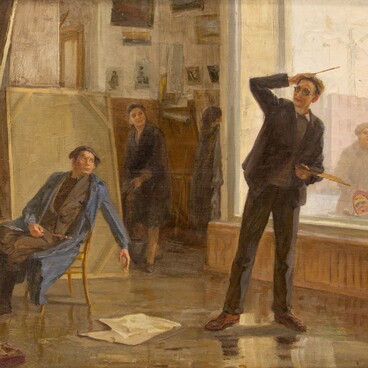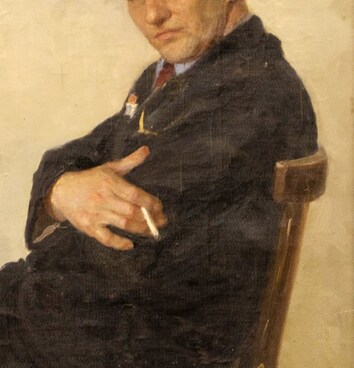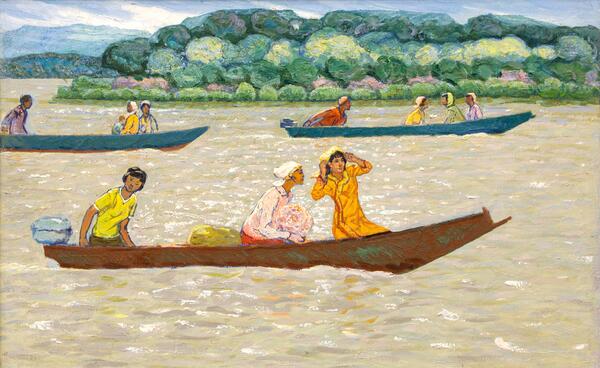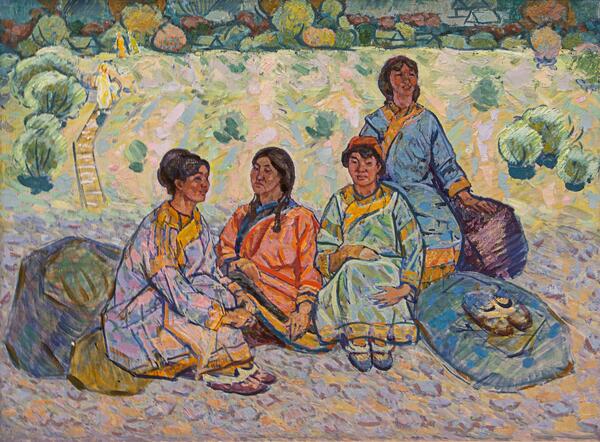Georgy Semyonovich Lee Girsu (1922–1995) was an ethnic Korean painter, born in Primorsky Krai. After graduating from two art institutions — the Samarkand College (1942) and the Leningrad Repin Institute (1949), he was assigned to teach painting in Birobidzhan.
Early in his career, Lee Girsu was an adherent of academism. Everything changed in 1954 when he was invited by the artist Georgy Aleksandrovich Tsivilyov to come work in Komsomolsk-on-Amur. There, Georgy Lee Girsu discovered and fulfilled his unique style, which art historians described as “shimmering”, “airy”, and “silvery”.
The artist worked in different genres and created theme paintings, portraits, and still lifes, but over time, landscape painting became a predominant part of his career — its features were present in all his works one way or another. Lee Girsu viewed painting as one of the best means of getting to know and improving oneself, and the importance of nature as the beginning of the universe fit his philosophy perfectly. The artist could spend years working on a single painting, as for him it was first and foremost a reflective process.
The landscape “Late Autumn” is painted in warm, soft shades of green, blue, light blue, gray-lilac, ochre, and brown. The artist had his own system of applying paint. Using small vibrating brushstrokes and gentle touches of pastel, he managed to make the clouds, the water, and even the air seem moving. The river flow and the clouds above harmonize with each other in a silent symphony.
Unlike his studies, Georgy Lee Girsu’s paintings do not seek to convey the features of a particular area but rather create a generalized image of Far Eastern nature, which enthralled the artist with its vastness, splendor and purity. Olga Yuryevna Privalova, director of the Metamorphosis Gallery of Contemporary Art, recalled that this “kind and cheerful man…loved the Far Eastern spring.” The artist also liked autumn — the time of rebirth and decay of nature when there is a certain tension in the air and people tend to reflect on the meaning of life.
In 1993, Georgy Semyonovich Lee Girsu became an honorary citizen of the city of Komsomolsk-on-Amur.
Early in his career, Lee Girsu was an adherent of academism. Everything changed in 1954 when he was invited by the artist Georgy Aleksandrovich Tsivilyov to come work in Komsomolsk-on-Amur. There, Georgy Lee Girsu discovered and fulfilled his unique style, which art historians described as “shimmering”, “airy”, and “silvery”.
The artist worked in different genres and created theme paintings, portraits, and still lifes, but over time, landscape painting became a predominant part of his career — its features were present in all his works one way or another. Lee Girsu viewed painting as one of the best means of getting to know and improving oneself, and the importance of nature as the beginning of the universe fit his philosophy perfectly. The artist could spend years working on a single painting, as for him it was first and foremost a reflective process.
The landscape “Late Autumn” is painted in warm, soft shades of green, blue, light blue, gray-lilac, ochre, and brown. The artist had his own system of applying paint. Using small vibrating brushstrokes and gentle touches of pastel, he managed to make the clouds, the water, and even the air seem moving. The river flow and the clouds above harmonize with each other in a silent symphony.
Unlike his studies, Georgy Lee Girsu’s paintings do not seek to convey the features of a particular area but rather create a generalized image of Far Eastern nature, which enthralled the artist with its vastness, splendor and purity. Olga Yuryevna Privalova, director of the Metamorphosis Gallery of Contemporary Art, recalled that this “kind and cheerful man…loved the Far Eastern spring.” The artist also liked autumn — the time of rebirth and decay of nature when there is a certain tension in the air and people tend to reflect on the meaning of life.
In 1993, Georgy Semyonovich Lee Girsu became an honorary citizen of the city of Komsomolsk-on-Amur.




